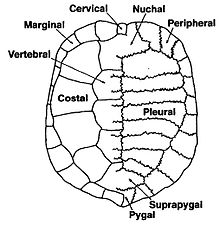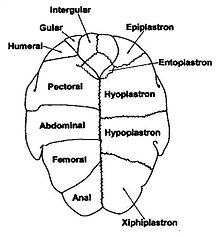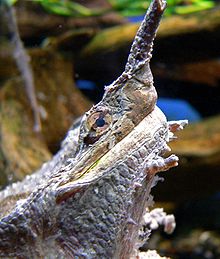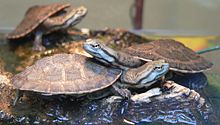- Chelidae
-
Chelidae
Temporal range: Albian–Recent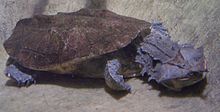
Chelus fimbriatus Scientific classification Kingdom: Animalia Phylum: Chordata Class: Sauropsida Order: Testudines Suborder: Pleurodira Family: Chelidae
Gray, 1831[1]Genera See Text
The Chelidae are one of the three living families of the turtle suborder Pleurodira and are commonly called the Austro-South American Side Neck turtles.[2] The Family is distributed in Australia, New Guinea, parts of Indonesia and throughout most of South America. It is a large family of turtles with a significant fossil history going back to the Cretaceous. The family is entirely Gondwanan in its origin with no members found outside of Gondwana, either in the present day or as a fossil.[3]
Contents
Description
Like all Pleurodirous turtles the Chelid's withdraw their necks sideways into the shell, differing from Cryptodire's that fold their necks in the vertical plane. They are all highly aquatic species with webbed feet and the capacity to stay submerged for long periods of time. The snake-necked species (genera: Chelus, Chelodina and Hydromedusa) are largely strike and gape hunters or foragers feeding on fish, invertebrates and gastropods. The short necked forms are largely herbivorous or molluscivorous but are also opportunistic, several species have specialized to eating fruits.
The highly aquatic nature of the group is typified by the presence of Cloacal Breathing in some species of the genera Elseya and Rheodytes.[4] However, species such as the Eastern Long-Neck Turtle (Chelodina longicollis) from Australia spend significant periods of time on land and is considered highly terrestrial.
The smaller members of the family include the Macleay River Turtle (Emydura macquarii) at around 16 cm,[5] Twist-necked turtle (Platemys platycephala) at 18 cm and the Western Swamp Turtle (Pseudemydura umbrina) at 15 cm. Whereas the larger species such as the Mata mata (Chelus fimbriata) and the White-Throated Snapping Turtle (Elseya albagula) both exceed 45 cm in shell length.[6]
Shell morphology
Members of the Chelidae have unique shell morphology. The carapace often has reduced surface exposure of neural bones, or even none at all (Thomson & Georges, 1996).[7] This is due to less requirement for enlarged longissimus dorsi muscles in side necked turtles (Thomson, 2003).[8] The inside of the carapace is often heavily buttressed. This has sometimes been seen as a defense mechanism, that is it increases the strength of the shell against biting force, however Thomson (2003[8]) demonstrated it is linked to feeding methods and the prevention of internal torsion of the shell. Chelid's also lack Mesoplastra which separates them from the Pelomedusidae.
The cervical scute is usually present though it is absent in some species of Elseya and Myuchelys. Otherwise the carapace has the usual complement of 4 costals, 5 vertebrals and 12 marginals (per side). Internally the carapace is made of 8 pleurals (per side), 11 peripherals (per side), a nuchal at the front and a suprapygal and pygal at the rear of the shell. As noted earlier neurals although always present often exist as subsurface elements above the vertebral column.[7]
The plastron of Chelids does not contain any hinges as can appear in some Cryptodire turtles. The scute pattern is a unique feature of the Pleurodira and can be used to immediately identify a shell as belonging to this suborder. All Cryptodire's have 12 plastral scutes whereas Pleurodires have 13. The extra scute is called the intergular. The rest of the scutes and the skeletal structure beneath them are the same as all turtles: paired gulars, humerals, pectorals, abdominals, and anals. The skeletal elements consist of a single entoplaston, as well as paired epiplastra, entoplastra, hyoplastra, hypoplastra and xiphiplastra (Pritchard & Trebbau, 1984).[9]
Classification
There have been a number of theories of the relationshps within the large Chelidae family. Using shared derived characters an early attempt in the 1970s used strict parsimony to determine that the 3 long-necked genera (Chelodina, Chelus and Hydromedusa) were each others closest relatives (Gaffney, 1977).[10] This was accepted for sometime but brought into scrutiny by Pritchard (1984)[11] who discussed the major differences between the 3 genera showing that they all appeared to have evolved independently of each other, hinging on the fact that although they had long-necks, how they used them and the structural differences were different.
A number of additional datasets were developed that used electrophoresis and nuclear and mtDNA analysis these all agreed on the independent evolution of the 3 long-necked clades (Georges et al. 1998,[12] Seddon et al., 1997[13]). This was culminated in a re-analysis of the morphological data which demonstrated the convergence of the 3 clades on a sweep of distinctive features needed for their piscivorous diet (Thomson, 2003,[14] Thomson, 2000.[15] The 3 sub-families within the Chelidae show the monophyly of the majority of the South American species and all the Australian species. With the far more ancient Hydromedusa as sister taxon to both these other groups.
The family Chelidae contains approximately 60 species within around 20 genera. Following based on Georges et al. 1998.[12]
Suborder Pleurodira
- Family Pelomedusidae
- Family Podocnemididae
- Family CHELIDAE Gray, 1831[1]
- Subfamily Chelodininae
- Genus Chelodina Fitzinger 1826 – Australian Snake-necked Turtles
- Genus Elseya Gray 1867 – Australian Snapping Turtles[16]
- Genus Emydura Bonaparte 1836 – Australian Short-necked Turtles
- Genus Elusor, Cann & Legler, 1994[17] – Mary River Turtle
- Genus Myuchelys Thomson & Georges 2009[18] – Australian Saw Shelled Turtles
- Genus Pseudemydura Siebenrock 1901[19] – Western Swamp Tortoise
- Genus Rheodytes Legler and Cann 1980,[20] – Fitzroy River Turtles
- Subfamily Chelidinae
- Genus Chelus Duméril 1806 – Matamata Turtles
- Genus Acanthochelys Gray, 1873[21] – South American Side-necked Swamp Turtles
- Genus Mesoclemmys – Gibba Turtle
- Genus Phrynops – Toad-headed Turtles
- Genus Platemys Wagner 1830 – Twisted-necked Turtles
- Genus Rhinemys – Red-headed Sideneck Turtle
- Genus †Bonapartemys Lapparent de Broin and de la Fuente 2001[22]
- Genus †Lomalatachelys Lapparent de Broin and de la Fuente 2001[22]
- Genus †Prochelidella Lapparent de Broin and de la Fuente 2001[22]
- Genus †Palaeophrynops Lapparent de Broin and de la Fuente 2001[22]
- Genus †Parahydraspis Wieland 1923
- Genus †Linderochelys de la Fuente et al. 2007
- Subfamily Hydromedusinae
- Genus Hydromedusa Wagler 1830 – South American Snake-necked Turtles
- Genus †Yaminuechelys de la Fuente et al. 2001
- Subfamily Chelodininae
Key to Australasian Chelidae 1 Forelimbs each with five claws; gular scutes separated by the intergular; intergular scute in broad contact with the anterior margin of the plastron 2
– Forelimbs each with four claws; gular scutes in contact; intergular scute not in broad contact with the anterior margin of the plastron Chelodina2 Intergular scute not in contact with the pectoral scutes 3
– Intergular scute contacts and partly separates the pectoral scutes Pseudemydura3 Suture between the second and third costal scutes contacting the seventh marginal scute; suture between the third and fourth costal scutes contacting the ninth marginal scute 4
– Suture between the second and third costal scutes contacting the sixth marginal scute; suture between the third and fourth costal scutes contacting the eighth marginal scute Rheodytes4 Surface of the temporal region covered with distinct regular scales or low tubercles; dorsal surface of the head with a prominent head shield which may be entire or fragmented; cervical scute present or absent 5
– Skin of the temporal region smooth, sometimes broken into regular scales of low relief; dorsal surface of head without a prominent head shield; cervical scute present (except as a rare variant) Emydura5 Precloacal tail length greater than postcloacal length only in adult males; tail round in cross section; cloacal orifice round; tail always shorter than half of carapace length 6
– Tail distinctive and large; precloacal length greater than postcloacal length at all ages in both sexes; tail laterally compressed; cloacal orifice a longitudinal slit; tail up to 53% of carapace length in adult males Elusor6 Prominent alveolar ridge on the triturating surfaces of the mouth; cervical scute absent (except as a rare variant); no prominent process of the head shield extending down the parietal ridge toward the tympanum Elseya
–Alveolar ridge absent; cervical scute absent in Australian species (except as a rare variant), present in New Guinea species (except as a rare variant); posterior process of the head shield extends laterally down the parietal ridge toward the tympanum MyuchelysPhylogeny
Relationships of the living forms based on Georges et al., 1998.[12]
Chelidae Hydromedusinae Chelidinae Chelus
Rhinemys
Platemys
Chelodininae Pseudemydura
Elusor
Rheodytes
References
- ^ a b Gray, J. E. 1831. Synopsis Reptilium or short descriptions of the species of reptiles. Part 1. Cataphracta, tortoises, crocodiles, and enaliosaurians. London. 85 pp.
- ^ Obst, Fritz Jurgen (1998). Cogger, H.G. & Zweifel, R.G.. ed. Encyclopedia of Reptiles and Amphibians. San Diego: Academic Press. pp. 111–112. ISBN 0-12-178560-2.
- ^ Georges, A., & Thomson, S. 2006. Evolution and Zoogeography of Australian freshwater turtles. In: Merrick, J.R., Archer, M., Hickey, G., and Lee, M. (eds.), Evolution and Zoogeography of Australasian Vertebrates. Sydney: Australia.
- ^ Gordos, M.A., C.E. Franklin & C.J. Limpus (2004). Effect of water depth and water velocity upon the surfacing frequency of the bimodally respiring freshwater turtle, Rheodytes leukops. The Journal of Experimental Biology. 207:3099-3107.
- ^ Cann, J. (2008) Freshwater Turtles: A Wild Australia Guide, Qld, Australia: Steve Parish Publishing, p. 46.
- ^ Thomson, S., Georges, A. and C. Limpus, (2006). A New Species of Freshwater Turtle in the Genus Elseya (Testudines: Chelidae) from Central Coastal Queensland, Australia. Chelonian Conservation and Biology. 5(1):74-86.
- ^ a b Thomson, S. and Georges, A. 1996. Neural bones in chelid turtles. Chelonian Conservation and Biology 2:82-86.
- ^ a b Thomson S. 2003. Long necks, flat heads and the evolution of piscivory. World Chelonian Trust
- ^ Peter C. H. Pritchard and Pedro Trebbau 1984. Turtles of Venezuela. Society for the Studies of Amphibians and Reptiles: 403 pp.
- ^ Gaffney, E.S. 1977. The side-necked turtle family Chelidae: a theory of relationships using shared derived characters. American Museum Novitates 2620:1-28.
- ^ Pritchard, P.C.H. 1984. Piscivory in turtles, and evolution of the long-necked chelidae. in Ferguson, M.W. (ed) The structure, development and evolution of reptiles. Zoological Society of London, Symposium. 52:87-110.
- ^ a b c Georges, A.; J. Birrell, K. M. Saint, W. McCord und S. C. Donnellan (1998) A phylogeny for side-necked turtles (Chelonia: Pleurodira) based on mitochondrial and nuclear gene sequence variation Biological Journal of the Linnean Society 67: 213-246
- ^ Seddon, J., Georges, A., Baverstock, P. and McCord, W. 1997. Phylogenetic relationships of chelid turtles (Pleurodira: Chelidae) based on mitochondrial 12S rRNA gene sequence variation. Molecular Phylogenetics and Evolution. 7:55-61.
- ^ Thomson S. (2003). Long necks, flat heads and the evolution of piscivory. World Chelonian Trust
- ^ Thomson S.A. (2000). On the identification of the holotype of Chelodina oblonga (Testudinata: Chelidae) with a discussion of the taxonomic implications. Chelonian Conservation and Biology 3:745-749.
- ^ Gray, J.E. (1867) Description of a new Australian tortoise (Elseya latisternum). Ann. Mag. Nat. Hist. (3) 20: 43-45.
- ^ Cann, J. and Legler, J.M. (1994). The Mary River Tortoise: a new genus and species of short-necked chelid from Queensland, Australia (Testudines; Pleurodira). Chelonian Conservation and Biology 1(2):81-96.
- ^ Thomson, S. & Georges, A. (2009) Myuchelys gen. nov. — a new genus for Elseya latisternum and related forms of Australian freshwater turtle (Testudines: Pleurodira: Chelidae) Zootaxa 2053: 32–42.
- ^ Seibenrock, F. 1901. Beschreibung einer neuen schildkrotengattung aus der familie Chelydidae aus Australien: Pseudemydura. Anz. Akad. Wiss. Wien 38:248-251.
- ^ Legler, J.M. & Cann, J. 1980. A new species of chelid turtle from Queensland, Australia. Contributions to Science (Natural History Museum of Los Angeles County) 324:1-18.
- ^ Gray, J.E. 1873. Observations on chelonians, with descriptions of new genera and species. Annals and Magazine of Natural History (4)11:289-308.
- ^ a b c d Broin, F. de. and de la Fuente, M.S. 2001. Oldest world Chelidae (Chelonii, Pleurodira), from the Cretaceous Patagonia, Argentina. Palaeontology 333:463-470.
External links and further reading
Side-necked turtle species Kingdom: Animalia · Phylum: Chordata · Class: Reptilia · Subclass: Anapsida · Order: Testudines · Suborder: Pleurodira Family Chelidae Chelodininae Chelodina canni · Chelodina longicollis · Chelodina mccordi · Chelodina novaeguineae · Chelodina reimanni · Chelodina steindachneri · Chelodina burrungandjii · Chelodina expansa · Chelodina parkeri · Chelodina rugosa · Chelodina collieiEmydura australis · Emydura macquarii · Emydura signata · Emydura subglobosa · Emydura tanybaraga · Emydura victoriaeMyuchelys latisternum · Myuchelys georgesi · Myuchelys purvisi · Myuchelys belli · Myuchelys novaeguineaePseudemyduraPseudemydura umbrinaRheodytesRheodytes leukopsChelidinae ChelusChelus fimbriatus (Mata mata)Mesoclemmys dahli · Mesoclemmys gibba · Mesoclemmys heliostemma · Mesoclemmys hogei · Mesoclemmys nasuta · Mesoclemmys perplexa · Mesoclemmys raniceps · Mesoclemmys tuberculata · Mesoclemmys vanderhaegei · Mesoclemmys zuliaePhrynops geoffroanus · Phrynops hilarii · Phrynops tuberosus · Phrynops williamsiRhinemysRhinemys_rufipesHydromedusinae Superfamily Pelomedusoidea Pelomedusinae PelomedusaPelomedusa subrufaPelusios adansonii · Pelusios bechuanicus · Pelusios broadleyi · Pelusios carinatus · Pelusios castanaeus · Pelusios castanoides · Pelusios chapini · Pelusios cupulatta · Pelusios gabonensis · Pelusios marani · Pelusios nanus · Pelusios niger · Pelusios rhodesianus · Pelusios sinuatus · Pelusios subniger · Pelusios upembae · Pelusios williamsiPodocnemidinae ErymnochelysErymnochelys madagascariensisPeltocephalusPeltocephalus dumerilianusPodocnemis expansa · Podocnemis unifilis · Podocnemis erythrocephala · Podocnemis lewyana · Podocnemis sextuberculata · Podocnemis vogliCategories:
Wikimedia Foundation. 2010.

